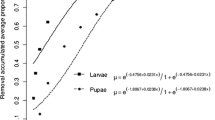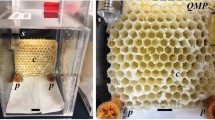Abstract
Invasion ofVarroa mites into honeybee brood cells was studied in an observation hive, using combs with cell openings at one side only. The cell bottoms had been replaced by a transparent sheet, through which mites were clearly visible after invasion into a cell. Mites invaded worker cells from 15–20 h preceding cell capping, whereas they invaded drone cells from 40–50 h preceding capping. The larger number of mites generally found in drone cells, when compared to worker cells, may be partly due to the longer period of mite invasion into drone brood.
Similar content being viewed by others
References
Boecking, O. and Drescher, W., 1991. Response ofApis mellifera L. colonies infested withVarroa jacobsoni Oud. Apidologie, 22: 237–241.
Boot, W.J., Calis, J.N.M. and Beetsma, J., 1992a. Invasion byVarroa mites into honeybee brood cells; A matter of chance or choice? (in prep.)
Boot, W.J., Sisselaar, D.J.A., Calis, J.N.M. and Beetsma, J., 1992b. Invasion byVarroa mites into honeybee brood cells; Factors affecting the rate of invasion. (in prep.)
Brouwers, E.V.M., Ebert, R. and Beetsma, J., 1987. Behavioural and physiological aspects of nurse bees in relation to the composition of larval food during caste differentiation in the honeybee. J. Apic. Res., 26: 11–23.
de Jong, D., 1984. Current knowledge and open questions concerning reproduction in the honey bee miteVarroa jacobsoni. In: W. Engels, W.H. Clark Jr, A. Fischer, P.J.W. Olive and D.F. Went (Editors), Advances in Invertebrate Reproduction, 3. Elsevier, Amsterdam, pp. 547–552.
Fuchs, S., 1990. Preference for drone brood cells byVarroa jacobsoni Oud. in colonies ofApis mellifera carnica. Apidologie, 21: 193–199.
Fuchs, S. and Langenbach, K., 1989. Multiple infestation ofApis mellifera L. brood cells and reproduction inVarroa jacobsoni Oud. Apidologie, 20: 257–266.
Fuchs, S. and Müller, K., 1988. Invasion of honeybee brood cells byVarroa jacobsoni in relation to the age of the larva. In: R. Cavalloro (Editor), European Research on Varroatosis Control. A.A. Balkema, Rotterdam, pp. 77–79.
Grobov, O.F., 1977. Varroasis in bees. In: V. Harnaj (Editor), Varroasis: a Honeybee Disease. Apimondia, Bucharest, pp. 46–90.
Ifantidis, M.D., 1984. Parameters of the population dynamics of theVarroa mite on honeybees. J. Apic. Res., 22: 200–206.
Ifantidis, M.D., 1988. Some aspects of the process ofVarroa jacobsoni mite entrance into honey bee (Apis mellifera) brood cells. Apidologie, 19: 387–396.
Ifantidis, M.D. and Rosenkranz, P., 1988. Reproduktion der BienenmilbeVarroa jacobsoni (Acarina: Varroidae). Entomol. Gen., 14: 111–122.
Le Conte, Y., Arnold, G., Trouiller, J., Masson, C., Chappe, B. and Ourisson, G., 1989. Attraction of the parasitic miteVarroa to the drone larvae of honey bees by simple aliphatic esters. Science, 245: 638–639.
Otten, C. and Fuchs, S., 1988. Individual differences inVarroa jacobsoni of preference for drone larvae to worker bee larvae. In: R. Cavalloro (Editor), European Research on Varroatosis Control. A.A. Balkema, Rotterdam, pp. 69–71.
Peng, Y.-S., Fang, Y., Xu, S. and Ge, L., 1987. The resistance mechanism of the Asian honey bee,Apis cerana Fabr., to an ectoparasitic mite,Varroa jacobsoni Oudernans. J. Invertebrate Pathol., 49: 54–60.
Rath, W. and Drescher, W., 1990. Response ofApis cerana Fabr. towards brood infested withVarroa jacobsoni Oud. and infestation rate of colonies in Thailand. Apidologie, 21: 311–321.
Ritter, W., 1981.Varroa disease of the honeybeeApis mellifera. Bee World, 62: 141–153.
Rosenkranz, P., Tewarson, N.C. and Engels, W., 1984. Optimal host selection by reproductive femaleVarroa jacobsoni. In: W. Engels, W.H. Clark Jr, A. Fischer, P.J.W. Olive and D.F. Went (Editors), Advances in Invertebrate Reproduction, 3. Elsevier, Amsterdam, pp. 628.
Schulz, A.E., 1984. Reproduktion und Populationsentwicklung der parasitischen MilbeVarroa jacobsoni Oud. in Abhängigkeit vom Brutzyclus ihres WirtesApis mellifera L. Apidologie, 15: 401–420.
Vet, L.E.M., van Lenteren, J.C., Heymans, M. and Meelis, E., 1983. An airflow olfactometer for measuring olfactory responses of hymenopterous parasitoids and other small insects. Physiol. Entomol., 8: 97–106.
Wieting, J. and Ferenz, H.-J., 1991. Behavioral study on the invasion of honeybee brood by the miteVarroa jacobsoni on wax combs and ANP combs. American Bee J., 131: 117–118.
Author information
Authors and Affiliations
Rights and permissions
About this article
Cite this article
Boot, W.J., Calis, J.N.M. & Beetsma, J. Differential periods ofVarroa mite invasion into worker and drone cells of honey bees. Exp Appl Acarol 16, 295–301 (1992). https://doi.org/10.1007/BF01218571
Issue Date:
DOI: https://doi.org/10.1007/BF01218571




